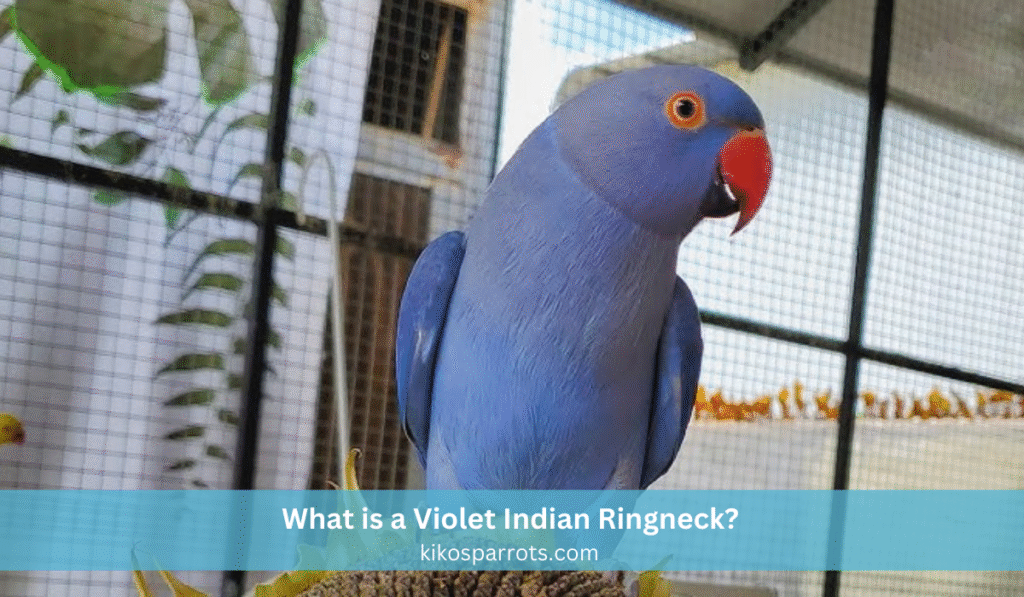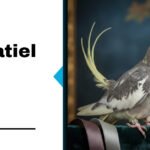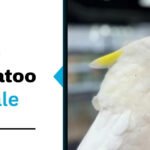

Violet Indian Ringneck Price, Lifespan, & Care Guide
The Violet Indian Ringneck is a strikingly beautiful parrot, admired for its vivid coloration, intelligence, and charming personality. This guide is designed for both first-time bird owners and experienced parrot enthusiasts. It covers essential information, including their origin, care needs, lifespan, diet, housing, pricing, and where to find one, particularly from trusted sources like Dallas Parrots.

What is a Violet Indian Ringneck?
The Violet Indian Ringneck is a unique color mutation of the Indian Ringneck Parakeet. These parrots show off sleek violet feathers and a vibrant ring around their necks, making them stand out with stunning beauty. They are known for their intelligence, social nature, and ability to mimic human speech. This combination of traits makes them not only visually appealing but also engaging companions for bird lovers.
Characteristics
Violet Indian Ringnecks grow as medium-sized parrots and usually weigh between 100 to 150 grams. A distinctive ring develops as they mature, complementing their vibrant plumage beautifully. These birds are highly social and thrive on interaction, making them great pets for families. Additionally, they require mental stimulation to keep them happy and healthy.
Origin, Natural Habitat, and Conservation Status
Violet Indian Ringnecks originate from parts of Asia, especially India and Sri Lanka. They live in diverse environments such as forests, woodlands, and farmlands. While they aren’t endangered, some regions enforce protective measures to conserve wild populations. These efforts preserve their natural habitats and support the species’ long-term survival.
Habitat Preferences
In the wild, these parrots prefer open areas with access to trees for nesting and foraging. They are often seen in flocks, which provides them with social interaction and safety in numbers. Their adaptability allows them to thrive in both rural and urban settings, where they can find food and shelter. Conservation efforts focus on preserving their natural habitats to prevent habitat loss.
Conservation Efforts
While the Violet Indian Ringneck is not endangered, various organizations actively protect their populations in the wild. These efforts include habitat restoration and legal protections in certain regions. Public awareness campaigns also aim to educate people about the importance of preserving these beautiful birds and their environments. By supporting conservation initiatives, we can help ensure the survival of the Violet Indian Ringneck for future generations
Why They Are Considered Exotic and Rare
Several reasons make the Violet Indian Ringneck an exotic and rare parrot. First, the violet color mutation doesn’t occur in the wild, which makes these birds unique among their species. Second, their stunning coloration and engaging personalities make them highly sought after by bird enthusiasts and collectors alike. Lastly, breeding these specific mutations is more complex and selective, contributing to their rarity in the pet market.
Rarity of Mutation
Violet is a rarer mutation that occurs naturally in the genetic makeup of the Indian Ringneck. This rarity elevates their status among other parrot varieties, as they are not commonly seen in their natural habitats. The unique genetic traits that produce this coloration require careful breeding practices, which limits their availability. As a result, many bird lovers view owning a Violet Indian Ringneck as a special privilege.
Demand and Popularity
The stunning color and charming personality of the Violet Indian Ringneck make them highly sought after in the pet trade. Their ability to mimic speech and interact socially adds to their appeal, attracting both novice and experienced bird owners. This high demand often leads to increased prices, further solidifying their status as an exotic pet. The combination of rarity and desirability makes them a prized addition to any bird collection.
Breeding Complexity
Breeding Violet Indian Ringnecks involves a more complex and selective process compared to standard color variants. Breeders must carefully select parent birds to ensure the desired violet mutation is passed on to the offspring. This meticulous breeding process requires knowledge of genetics and a commitment to ethical practices. The challenges associated with breeding these parrots contribute to their rarity and increase their value in the market.

Violet Indian Ringneck Available at Dallas Parrots!
If you’re in search of a Violet Indian Ringneck, Dallas Parrots is a trusted source for healthy, hand-raised parrots. They prioritize the well-being of their birds and ensure that each one is raised in a nurturing environment. Additionally, Dallas Parrots offers expert guidance and aftercare support, making it easier for new owners to provide the best care for their pets.
Trusted Source
Dallas Parrots earns recognition for its strong commitment to quality and bird health. They perform thorough health checks and provide full documentation with every parrot sold, ensuring buyers stay well-informed. Moreover, their solid reputation in the community makes them a trusted choice for anyone wanting to adopt a Violet Indian Ringneck. This level of trust plays a key role for future owners who want a healthy and happy companion.
Expert Guidance and Support
In addition to offering healthy birds, Dallas Parrots provides expert guidance on care and nutrition. They understand that new bird owners may have questions or concerns, and their team is ready to assist. This ongoing support includes advice on diet, housing, and behavioral training, helping owners create a positive environment for their parrots. Such comprehensive care ensures that both the bird and owner thrive together.
Diet and Nutrition
A balanced diet is essential for the health and well-being of a Violet Indian Ringneck. Their diet should primarily consist of high-quality pellets, supplemented with fresh fruits and vegetables. While seeds can be offered as occasional treats, they should not form the staple of their diet. Fresh water and calcium supplements are also crucial for maintaining their overall health.
Balanced Diet Components
The core of a Violet Indian Ringneck’s diet should include specially formulated pellets designed for parrots. These pellets provide essential nutrients that support their health and longevity. Fresh fruits and vegetables should be added daily to introduce variety and additional vitamins. This balanced approach ensures that the bird receives all necessary nutrients for optimal health.
Treats and Supplements
Seeds can be given as occasional treats but should be limited to prevent obesity and nutritional imbalances. Fresh water must always be available, and regular changes are necessary to keep it clean. Additionally, calcium supplements are important for bone health, especially during breeding seasons. Owners should also be aware of foods that are toxic to parrots, such as avocado, chocolate, and caffeine, to ensure their safety.
Toxic Foods to Avoid
Certain foods are harmful to parrots and should be strictly avoided. Avocado is known to be toxic, causing serious health issues in birds. Chocolate and caffeine can also be lethal, impacting their heart and nervous systems. Educating oneself about these dangers is crucial for any bird owner, as it helps prevent accidental ingestion and promotes a safe environment for the Violet Indian Ringneck.
Appearance and Temperament
The Violet Indian Ringneck is renowned for its striking appearance and engaging temperament. These parrots feature vibrant violet plumage, complemented by a distinct ring around their necks that becomes more pronounced as they mature. Their physical beauty is matched by their lively and intelligent personalities, making them wonderful companions for bird enthusiasts.
Physical Characteristics
The Violet Indian Ringneck typically measures about 16 to 18 inches in length, including their long tail feathers. Their vibrant violet color can vary in shade, with some birds displaying deeper hues than others. In addition to their beautiful feathers, they have a strong, curved beak and expressive eyes that contribute to their charming appearance. This combination of features makes them a visually stunning addition to any home.
Personality Traits
These parrots are known for their playful and social nature. They thrive on interaction with their owners and can form strong bonds with humans. Violet Indian Ringnecks are also highly intelligent, making them capable of learning tricks and mimicking speech. Their curious and adventurous spirits mean they enjoy exploring their surroundings, which can lead to entertaining and engaging behaviors.
Lifespan of a Violet Indian Ringneck: How Long Do They Live?
The average lifespan of a Violet Indian Ringneck ranges from 25 to 30 years with proper care. This longevity makes them a long-term commitment for potential owners. Some individuals have been known to live even longer in safe and loving environments, with reports of birds reaching up to 40 years of age.
Factors Influencing Longevity
The lifespan of a Violet Indian Ringneck largely depends on several key factors, including diet, activity levels, regular veterinary care, and mental stimulation. A balanced diet rich in nutrients, combined with daily exercise and social interaction, contributes to their overall health. Regular check-ups with an avian vet help catch any potential health issues early, ensuring a longer, healthier life.
Importance of Mental Stimulation
Mental stimulation is crucial for the well-being of these intelligent birds. Engaging them in interactive play, training sessions, and providing a variety of toys can prevent boredom and promote mental health. A stimulating environment not only enhances their quality of life but also encourages longevity, as mentally active birds are generally healthier and happier.
Essential Care Tips
Caring for a Violet Indian Ringneck requires commitment and attention. These birds need daily interaction and socialization to thrive. Establishing a routine that includes playtime and bonding activities is essential for their emotional well-being.
Daily Interaction
Violet Indian Ringnecks are social creatures that require daily interaction with their owners. Spending time with them helps strengthen the bond and reduces feelings of loneliness. Engaging in activities such as talking, playing, and training can significantly enhance their happiness and reduce behavioral issues.
Toy Rotation and Mental Stimulation
To prevent boredom, it’s important to rotate their toys regularly. Introducing new toys and games encourages play and keeps them mentally stimulated. Additionally, incorporating training sessions that challenge their minds can further enhance their overall well-being. This variety helps maintain their interest and prevents destructive behaviors.
Health Monitoring
Regular monitoring for signs of illness or stress is crucial in providing proper care. Owners should be vigilant for changes in behavior, appetite, or vocalization, as these can indicate health issues. Establishing a good relationship with an avian veterinarian is also beneficial for regular check-ups and preventive care.
Price: How Much Does It Cost?
The average price of a Violet Indian Ringneck typically ranges between $400 and $800. However, various factors can influence the final cost.
Factors Affecting Price
Factors that affect the price include the rarity of the color mutation, the reputation of the breeder, and the age of the bird. Rarer mutations or those from well-known breeders may command higher prices. Additionally, younger birds may be priced differently compared to adults, as they often require more training and socialization.
Additional Costs
Beyond the initial purchase price, potential owners should also consider additional costs. Setting up a suitable cage, purchasing toys, providing a balanced diet, and regular veterinary visits can add to the overall expense. Budgeting for these ongoing costs is essential to ensure a healthy and happy environment for the Violet Indian Ringneck.
Housing and Cage Requirements
Providing a suitable living environment is essential for the health and happiness of a Violet Indian Ringneck. Their cage should be spacious enough to allow for movement and play, as well as equipped with various accessories to keep them engaged.
Cage Size and Structure
Choose a cage that’s at least 24” x 24” x 36” for your Violet Indian Ringneck, and make sure it has horizontal bars to encourage climbing. However, a larger cage is always better, as it gives your parrot more space to move and explore. Additionally, ensure the bars are spaced about ½ inch apart to prevent injury or escape. This setup creates a safe and comfortable environment for your bird.
Enrichment and Accessories
Inside the cage, it’s important to provide various perches, swings, and climbing toys to encourage physical activity. Natural wood perches of different diameters are ideal, as they promote foot health. Additionally, incorporating toys that stimulate their minds, such as foraging puzzles, can help prevent boredom and destructive behaviors.
Maintenance and Location
Cleaning the cage regularly is crucial to maintain a healthy environment. This includes removing waste, replacing bedding, and sanitizing toys and perches. Proper ventilation is also important to prevent respiratory issues. The cage should be placed in a safe, social, and well-lit area of your home, away from direct sunlight and drafts, allowing your parrot to feel included in daily activities.

Training and Socialization
To keep your Violet Indian Ringneck affectionate and friendly, it’s important to spend time together regularly. Not only does daily interaction strengthen your bond, but it also helps reduce anxiety and stress in your bird. Furthermore, with patience and consistent effort, your parrot can learn to talk and mimic sounds. As a result, it becomes an even more delightful and engaging companion.
Early Training Techniques
Start training your Violet Indian Ringneck early by using step-up commands and bonding exercises. Build trust and communication with your bird through these basic skills. Stay consistent and practice daily to reinforce what your parrot learns.
Positive Reinforcement
Using positive reinforcement techniques, such as treats and praise, encourages desired behaviors. Rewarding your bird for following commands or engaging in social interactions helps build a positive association with training sessions. This approach fosters a loving bond and promotes a friendly demeanor.
Importance of Interaction
Spend time with your Violet Indian Ringneck regularly to keep it affectionate and friendly. Interacting daily strengthens your bond and reduces your bird’s anxiety and stress. With patience and consistent effort, your parrot can learn to talk and mimic sounds, making it an even more delightful companion.
A Violet Indian Ringneck for Sale: Where to Look and What to Consider
When looking to purchase a Violet Indian Ringneck, it’s crucial to find a reputable source to ensure the health and well-being of your new pet.
Reputable Sources
Consider purchasing from trusted breeders or pet stores like Dallas Parrots. These sources prioritize the health of their birds and often provide necessary documentation. Always do your research to ensure the seller has a good reputation in the bird community.
Health Records and Care
When acquiring a Violet Indian Ringneck, ask for health records and information about their feeding routines. This transparency can provide insight into the bird’s background and care needs. Additionally, ensure that the bird is hand-raised and socialized, as this will contribute to a better adjustment in your home.
Caution with Online Purchases
Be cautious of online scams or unverified sellers when searching for a Violet Indian Ringneck for sale. Always verify the credibility of the seller and look for reviews or testimonials from previous customers. Taking these precautions will help you find a healthy and happy bird to welcome into your home.
Is a Violet Indian Ringneck Right for You?
Bringing a Violet Indian Ringneck into your home takes serious commitment. These parrots do more than just sit pretty—they interact, engage, and crave social connection. Think about your lifestyle, living space, and ability to provide consistent care before making the decision.
Consider Your Lifestyle
Violet Indian Ringnecks require daily interaction and mental stimulation. If you lead a busy life or are frequently away from home, you may need to consider whether you can meet their social needs. These birds flourish in environments where they can bond with their owners and enjoy regular playtime.
Space and Environment
Ensure that you have enough space for a spacious cage and a safe area for them to explore outside the cage. A well-lit, social environment is essential for their well-being. Consider whether your living situation allows for a suitable setup that meets their needs.
Commitment to Care
Owning a Violet Indian Ringneck involves a long-term commitment, as these birds can live for 25 to 30 years or longer with proper care. You must be prepared to invest time and resources into their diet, health care, and socialization throughout their lives.
Conclusion
The Violet Indian Ringneck is more than just a pretty bird—it’s a lifelong companion full of charm, energy, and affection. With proper care, a nutritious diet, and a loving environment, they can thrive for decades. Whether you’re considering adoption or purchasing from a trusted breeder like Dallas Parrots, make sure you’re prepared for the responsibility.
This beautiful parrot will reward you with years of joy, interaction, and unforgettable companionship. By understanding their needs and committing to their care, you can create a fulfilling relationship that enriches both your life and theirs Follow our Social Media Pages Facebook and Instagram.
FAQ’s
What is the personality of a violet Indian Ringneck?
Violet Indian Ringnecks are known for their playful and curious nature. They are typically affectionate and can form strong bonds with their owners. These parrots are also intelligent and enjoy engaging in interactive play, making them lively companions.
What is the rarest Ringneck color?
The rarest color among Indian Ringnecks is often considered to be the “White” or “Lutino” mutation. These colors are less common compared to the typical green or blue variations, making them highly sought after by collectors.
Do Indian Ringneck parrots talk?
Yes, Indian Ringneck parrots are known for their remarkable ability to mimic human speech. With proper training and social interaction, they can learn a variety of words and phrases, often impressing their owners with their vocal skills.
Do Indian Ringnecks make good pets?
Indian Ringnecks can make excellent pets for those willing to invest time in their care and training. They are social birds that thrive on interaction, and with proper attention, they can be affectionate companions.
Are Ringnecks intelligent?
Yes, Indian Ringnecks are highly intelligent birds. They possess problem-solving skills and can learn tricks and commands, making them engaging pets that require mental stimulation.
What age are Ringnecks fully grown?
Indian Ringnecks typically reach full maturity around 2 to 3 years of age. At this stage, they exhibit their adult size and coloration, along with established personality traits.
Can parrots live for 140 years?
While some parrots can live for several decades, most species, including Indian Ringnecks, have a lifespan of 15 to 30 years in captivity. The claim of parrots living up to 140 years is often exaggerated and not typical for most parrot species.


